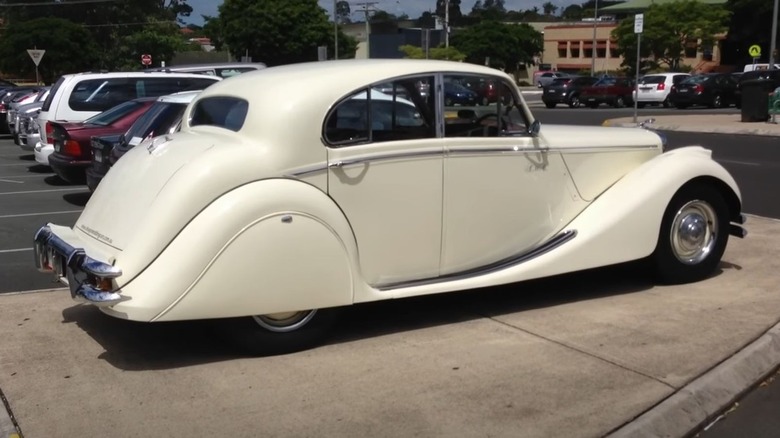The Classic Jaguar Saloon That Was A Masterpiece Of Craftsmanship
In September 1948, Jaguar unveiled the Mark V Saloon at the London Motor Show, making it the first post-World War II model to wear the "Jaguar" badge. Before the war, Sir William Lyons' company was known as "SS Cars," but afterwards decided to scrap the name entirely because it sounded much too similar to Hitler's Schutzstaffel (SS) troops for comfort, so he changed it to Jaguar Cars, Ltd.
The Mark V Saloon was equipped with a host of firsts and one notable last. Although Chief Engineer William Heynes developed the company's independent front suspension before the war, the Mark V was the first to use it. It's also the first Jag to feature four-wheel hydraulic drum brakes, sealed headlamps, and flashing turn signals. If that weren't enough, it was the company's first vehicle available in both left and right-side drive configurations but the last to feature a pushrod engine.
The name is also something of a conundrum. Several sources (Bonhams, GAUK Motors, and Conceptcarz.com) all agree that there were no previous "Mark" iterations of any kind. The belief is that Lyons fiddled with five different prototypes between 1946 and 1948 before landing on the one he liked, thus the Mark V designation. Interestingly, the Mark IV badge wasn't used until after the Mark V launched. Digging deeper reveals a Jaguar car club in Beverly Hills contends the Mark IV name was put on vehicles built between 1935 and 1949, while another source says it was an "unofficial" name given by the company.
This Jaguar marked the beginning of its post-war success
The Mark V was made between 1948 and 1951 and came in eleven different models. It was available first as a four-door saloon car, while the two-door drophead coupe came later. You could get strapped with a 2.5-liter or 3.5-liter engine. Jaguar only made about 10,500 Mark V's during its relatively short production run.
Lyons used the same Standard, six-cylinder, overhead-valve engines he dropped in his previous SS cars. The 2.5-liter version produced 102hp, while the bigger engine cranked out 125hp, which had a top speed of 90 miles per hour and went from zero to sixty in a rather snail-like 20.4 seconds.
The exterior boasted sweeping curves, chrome twin-blade bumpers and front grill, and rear-wheel fender skirts (aka spats) — another first for Jaguar. The Mark V's interior was adorned with leather chairs, walnut trim, and a host of instruments that relayed all essential vehicle information (i.e., speed, rpm, oil pressure, etc.). Jaguar offered seven different upholstery colors (none two-tone) and twelve different exterior single paint colors, but some exceptions were made, according to Conceptcarz.com.
If this quintessential British luxury car seems familiar, you can probably chalk it up to one of two things. First, it drips Royalty that just looks like a car the aristocracy would ride about in. More likely, though, it bears a striking similarity (especially to the untrained eye) to another British luxury car made a few years earlier with the same name — the Bentley Mark V.
